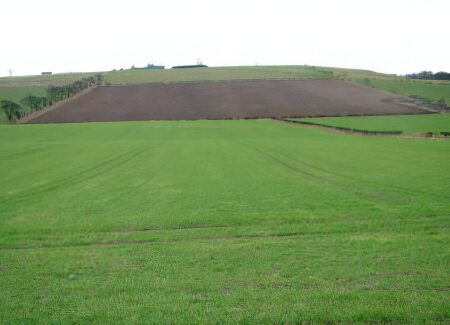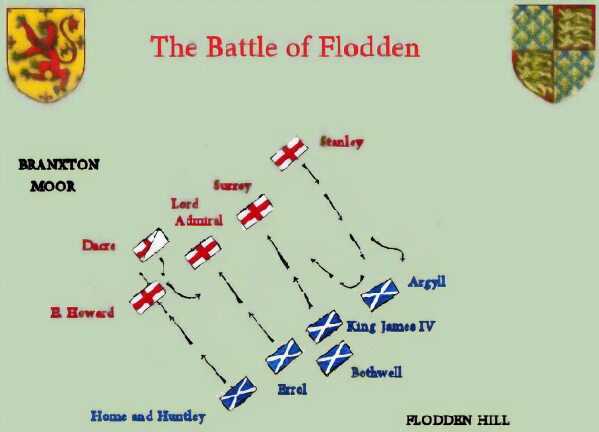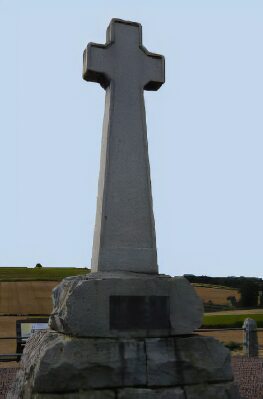James IV
The Battle of Flodden, sometimes referred to as the Battle of Branxton, one of the greatest defeats ever to be suffered by the Scots, was fought in Northumberland, in northern England on 9 September 1513.
James IV, King of Scots declared war on on the English King Henry VIII in suppport of the historic Auld Alliance with France, James was Henry's brother-in-law, being married to his sister Margaret Tudor. In an attempt to divert Henry's troops from their campaign against Louis XII, King of France.
Flodden Battlefield
England was at the time involved in the War of the League of Cambrai, defending Italy and the Pope from the French, as a member of the "Catholic League". In response Pope Leo X, excommunicated the Scottish king.
Henry VIII, in France with Emperor Maximilian at the siege of Thérouanne, was delivered a letter from James asking that he desist from attacking France in breach of their treaty. Henry's exchange with James' herald at his tent at the siege of Thérouanne on 11 August was a heated one. The Herald declared that Henry should abandon his campaign and return to England. Henry arrogantly dismissed James' letter and replied furiously that his brother-in-law had no right to summon him.
Hoping to take advantage of his brother-in-law's absence, James proceeded to the border with a huge army of Scots. The Earl of Surrey, son and heir of John Howard, 1st Duke of Norfolk, was ordered north to meet him by the English Regent, Henry VIII's first wife, Catherine of Aragon. Surrey marched to Durham where he prayed before the shrine of St Cuthbert at Durham Cathedral and collected the sacred banner of the saint. He then continued north to Newcastle, where he was joined by forces from Northumberland and Durham, including the retainers of Percy, Lord Dacre, the Bishop of Durham and William Bulmer of Brancepeth.
James and his army crossed the River Tweed near Coldstream and on 24th August. By the 29th August Norham Castle was taken and partly demolished. The Scots army then proceeded south, taking the castles of Etal and Ford.
Plan of the Battle of Flodden
later Scottish chronicle writer, Robert Lindsay of Pitscottie, claimed that James wasted valuable time at Ford enjoying the company of Elizabeth, Lady Heron and her daughter. An English herald arrived at Ford to appoint a place for battle on 4th September, part of the Scottish army then returned to Scotland, while the rest stayed at Ford waiting for the surrender of Norham.
The Scottish army was superior in size and artillery to Surrey's forces. James is said to have commanded over 30,000 men armed with the latest weaponry of Swiss pikes, early muskets and cannon. James IV was eager to fight and considered moving to assault Berwick on Tweed, the Earl of Angus counselled against moving on Berwick arguing that Scotland had already done enough for France but was ordered home by James.
Battle took place near the village of Branxton, in Northumberland. James positioned his army at Flodden Edge in the Cheviot Hills, less than 10 miles from the border, on 9th September 1513, the Scots army occupied a strong position on the ridge of a hill.
The Earl of Surrey compared this position to a fortress in his challenge sent to James IV by herald. He complained that James had agreed that they would meet in battle on Friday between 12.00 and 3.00 pm, and asked that James would face him on the plain at Milfield as appointed. He then moved to block the Scots' route north forcing James to move his army two miles to Branxton Hill, the move resulted in the Scottish cannon not be properly positioned and rendered them virtually useless.
At 11 o'clock, Thomas, Lord Howard's vanguard and artillery crossed the Twissell Bridge. James refused to allow the Scots artillery to fire on the vulnerable English during this manoeuvre. James and the Scottish lords lined up at the head of their army. The battle commenced with an exchange of cannon fire, the English cannon had a devastating effect on the Scottish formations, which took great losses. Hume and Huntly, positioned on the left of the Scottish line, decided to act without waiting for James' orders. They marched their troops down the hill and broke through the right of the English line, commanded by Lord Edmund Howard and were set upon by Dacre's horsemen.
James, a courageous soldier but a poor general, was no longer able to control his abiding anger and impatience and commanded Crawford and Montrose to advance. Throwing caution to the wind, James abandoned his strategic position and led his army in full charge down the hill under cannon fire to clash with the English. In a suicidal charge, the Scots army rode to attack the English uphill. James, fighting on foot, is said to have come to "within a spear's length" of Surrey. They were attacked on their flank by Lord Dacre. The two armies clashed in a slaughterous carnage in which the English steadily gained the advantage.
Flodden Memorial
Argyle and Lennox's Highlanders positioned on the right neglected to notice the arrival of Edward Stanley's division on their front. Advancing part of his troops to engage the Highlanders, the remainder were directed secretly to the left and up the hill. A massive storm of arrows was then unleashed on the Scots from two directions, forcing them to flee. Sighting Bothwell's men advancing to support Jame's division, Stanley and Dacre attacked the Scottish reserve from behind. The English troops then attacked the rear of the Scottish lines.
As dusk began to fall on Flodden Field, the flower of Scotland's chivalry lay dead on the field, James IV himself fought valorously in the thick of the battle, with courage even his opponents could but admire. He finally fell, his body pierced by many arrows and his neck severed by a bill. The English chronicler Edward Hall, recorded "the battle was cruel, none spared other, and the King himself fought valiantly". He had inspired such loyalty in the Scots that thousands of them had followed him, even to certain death, around 15,000 men died in the space of two and a half hours, a huge death toll, it is estimated that a quarter of the Scottish army met their deaths at Flodden.
The following morning, Lord Dacre discovered the body of James IV on the battlefield. He later wrote that the Scots "love me worst of any Englishman living, by reason that I find the body of the King of Scotts." The body was identified and removed from the mound of bloodied corpses that lay in the heaps upon the battlefield. After embalming, it was sent to Catherine of Aragon at Woburn Abbey. In poor taste, Catherine of Aragon proudly sent the blood-stained coat of her brother-in-law to Henry VIII in France as a victory token along with her congratulations.
James' wife, Margaret Tudor, is said to have awaited news of her husband at Linlithgow Palace, where a room at the top of a tower is called 'Queen's Margaret's bower.' The Scottish Parliament met at Stirling Castle on 21 October, where James' 17 month-old son was crowned as James V was crowned in the Chapel Royal.
James' disfigured body was sent to Sheen where, as he had been excommunicated by the Pope, it remained unburied, an exhibit for the curious. Further indignities were heaped upon it. It was slung into a lumber-room of Sheen monastery, where its head was hacked off by workmen.
There it remained until the reign of Queen Elizabeth I, when the remains of James' severed head were taken home by one Lancelot Young. The body was eventually laid to rest in an anonymous grave in a charnel pit, in St. Michael's churchyard along with other bones which had been cleared from the crypt.
The Battle of Stoke Field PreviousNext The Battle of Worcester
